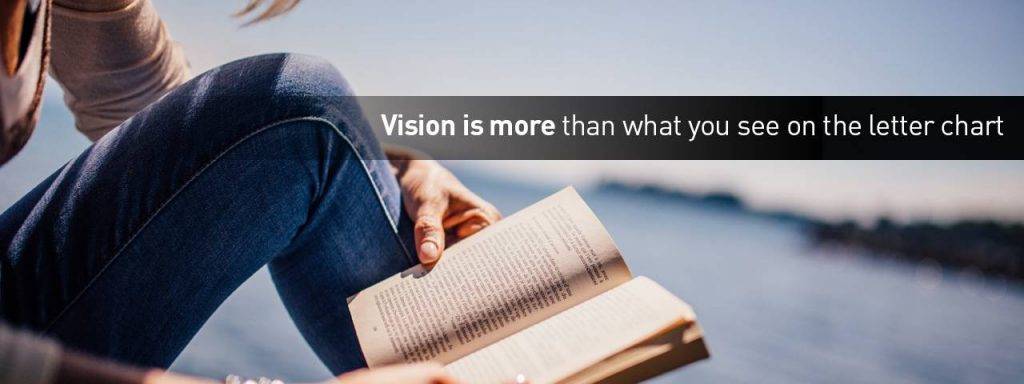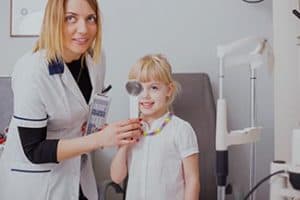Since 80 percent of all that is learned enters through the visual pathways, any type of visual problem can prevent a child from achieving academic success.
If your child struggles to read, they may have an undetected visual problem.
Reading fluency and comprehension is dependent on the strength of the visual skills— specifically, binocular vision, saccades, accommodation, visual fixation, and convergence.
A deficiency in any of these visual skills can result in reading difficulties, which can consequently impact a child’s ability to learn.
What is the difference between sight and vision?
Visual acuity is tested using a standardized chart during a school vision screening or a routine eye exam— this is an indication of your ‘sight’.
Your visual acuity is only the measurement of how clearly you are able to see distant objects.
The results of a visual acuity test are indicated by a numeric fraction, such as 20/20 or 20/40. The top number represents the distance from the chart (20 feet), and the bottom number represents the distance at which the average person with normal eyesight can correctly read the same line.
If you have 20/20 eyesight, you can assume that you have normal visual acuity, and are able to see what most people can see when they stand 20 feet away from an object.
However, having 20/20 eyesight doesn’t indicate perfect vision.
If you have 20/20 vision, this number is only a measurement of your distance vision acuity, and does not represent your near vision acuity, or the integrity of your visual skills.
Children may have 20/20 eyesight, with or without prescription glasses, and still experience reading and learning difficulties— usually as a result of reduced visual skills.
Which visual skills are necessary for reading?
- Visual fixation- the eye’s ability to accurately focus on a target image, such as a word on a page.
- Accommodation- the eyes’ ability to switch focus between two distances while maintaining clear vision.
- Binocular fusion- the brain’s ability to form a single image using the distinct visual information it receives from each eye.
- Saccades- rapid eye movements between two or more focus points, such as when the eyes move from one word to the next when reading a sentence across a page.
- Convergence- the eyes’ ability to maintain a single image by simultaneously turning inward to focus on a near object, such as a book or computer screen.
If your child has any of the signs below, contact an eye doctor near you to diagnose and treat any visual problems.
SEE RELATED: How Do Reading Glasses Help Children?
Does my child have a vision problem?
Identifying a vision problem in children can be difficult, as they may not know that they have a vision problem, or may lack the verbal skills to describe what they are experiencing.
Common signs to look out for that may indicate a vision problem:
- Behavioral problems
- Reading below school grade level
- Excessive fidgeting
- Limited attention span
- School avoidance
- Reading avoidance
- Reading comprehension difficulties
- Covering one eye
- Tilting head to one side
- Frequent blinking
If your child is displaying signs of a visual impairment, it is important to visit your eye doctor for a comprehensive evaluation of your child’s vision and visual skills.
How can vision therapy help?
Vision is a learned skill that can be trained and strengthened.
If a vision problem is at the root of your child’s reading difficulty, a program of vision therapy can help.
Each vision therapy program is customized to the individual needs of each child, and may include specialized lenses, prisms, filters, and eye exercises to help retrain the eye-brain connections and improve vision.
Keep in mind that reading issues can have multiple causes. Therefore, a multidisciplinary approach to the diagnosis and treatment of learning difficulties, including a team of eye doctors, neurologists, therapists and educators, will help ensure that your child reaches their maximum potential.
LEARN MORE: Guide to Children’s Eye Exams
If you think a vision problem may be hindering your child’s reading success, schedule a functional vision evaluation with a developmental optometrist.
A vision therapy program may help to improve your child’s visual skills and provide them with the necessary tools to succeed in reading and learning, and a lifetime of success.









